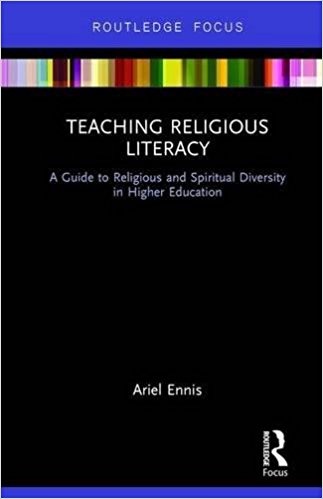inter-faith
Select an item by clicking its checkbox

Teaching Religious Literacy: A Guide to Religious and Spiritual Diversity in Higher Education
Date Reviewed: October 1, 2018
Ariel Ennis, Assistant Director and Senior Multifaith Educator at the Of Many Institute for Multifaith Leadership in the Office of Global Spiritual Life at New York University, has authored an important contribution to a burgeoning literature on campus-based interfaith and interreligious outreach. Noting that diversity and inclusion initiatives on American campuses frequently address race, sexuality, and gender while ignoring religious identity, Ennis reports on efforts at NYU to create a center to support spiritual life. Special attention is given to the development of a “Faith Zone” curriculum that trains leaders for enhanced multifaith encounters.
Ennis analyzes a variety of extant approaches to cross-cultural religious and spiritual experiences, looking at intended outcomes of different programs. Focusing on the concept of “religious literacy,” he describes a framework for the NYU workshops on spiritual diversity that supports religious literacy initiatives. Included in the book is the Faith Zone curriculum and rubrics drawn from the AACU (Association of American Colleges and Universities) VALUE rubrics that are used for post-workshop outcomes assessment. He shares data from these assessments in order to demonstrate the impact on campus of the religious literacy curriculum. The book closes with the author’s reflections on how Faith Zone workshops could be offered on different types of campuses (public/private, religious/secular) and with his recommendations for successfully meeting challenges emerging from the workshops.
Campus religious literacy initiatives that Ennis advocates embrace the question: Can we teach people to have more productive conversations about religion and spirituality in diverse settings? Using the definition of religious literacy developed by Dianne Moore of the Religious Literacy Project at Harvard Divinity School, Ennis answers this question affirmatively, setting four outcomes for the interfaith curriculum. Workshops will (1) enhance participants’ knowledge of historic and contemporary interconnections of religion with cultural, political, and social life; (2) embrace an ecumenical orientation that offers participants firsthand experience in exploring religio-cultural boundaries; (3) promote self-awareness about the intersections of participants\' religio-spiritual identities with larger social forces; and (4) encourage participants\' commitment to apply their new found religious literacy through practical projects that bridge intercultural divides.
In contrast to Eboo Patel’s portrait of a fraught relationship between interfaith outreach and religious studies programs (https://www.wabashcenter.wabash.edu/scholarship/interfaith-leadership-a-primer/), Ennis’ book points to positive implications for partnerships on campus between religious studies programs and interfaith outreach. Similarities between Faith Zone outcomes and learning outcomes/assessment of the religion major on many campuses suggest productive cross-fertilization. Students could sustain the long-term impact of the workshop outcomes, adding depth and breadth, through coursework in religious studies grounded in similar learning outcomes. In complementary fashion, religious studies majors could apply learning in the major outside the classroom, enhancing their resumes, through interfaith internships: as graduates of Faith Zone training, they could lead workshops on religious literacy and develop and lead associated campus programming.
What’s a Catholic College? I grew up agnostic and converted to Islam when I was eighteen. A lifetime later, I now teach at a Catholic, Jesuit, liberal arts college. Like many religious studies educators, I continue to mull over questions about the intersections of identity, metaphysics, and socio-politics. So, ...

Teaching the Historical Jesus: Issues and Exegesis
Date Reviewed: November 30, -0001
This collection highlights the depth and breadth of interest in the historical Jesus across various forms of higher education. Editor Zev Garber has done an outstanding job of assembling high quality scholar-teachers to explicate their framework for understanding Jesus in his social-historical setting. What makes the volume noteworthy for a faculty teaching theology and religion, however, is the reflection on how to teach this important subject in ways that are pertinently positioned for a variety of student audiences. Taken as a whole, the volume answers Rudolf Bultmann’s question, “Can there be exegesis without presuppositions?” with a resounding “no.” Each contributor clearly presents their own position, the background of their institutional context, and assumptions that surround the teaching of their group of students.
The collection is made up of twenty shorter essays and full comment on each cannot be made here. The first part of the volume examines teaching and student engagement from a variety of institutional contexts – primarily undergraduate, but including a rabbinical school and a Christian seminary. Further marks of delineation are private versus public; Protestant, Jewish, Catholic; and even a public community college. Some contributors function both in academia as well as in the training of religious leaders, formally or informally. Pedagogy is presented and explained, along with reflection on student questions, reactions, and participation in the learning process. The underlying purpose in doing this teaching work is to increase fruitful interfaith dialogue. The second section examines specific issues in teaching the historical Jesus – often these are difficulties encountered, with solutions suggested (for example, the use of art or cinema; the nature of Judaism and Jesus; the extended turn toward later Christian terms and theology; the use of gospel materials in reconstruction; clarity on the “parting of the ways”). The final section consists of four technically positioned essays about Jesus’s Jewish background and his roles within local, pan-Mediterranean, and larger political contexts of his society (who was Jesus among other males, the Pharisees, and political seditionists?).
If readers of Reflective Teaching believe that good teaching is enhanced by “good conversations about teaching,” then this volume is a gold mine. Garber has directed the contributors to be transparent about themselves, their contexts, and their students. This allows us to contrast them to our own pedagogies, experiences, expectations, and accomplishments or difficulties. In addition, we can be reminded that our own contexts may be busy and focused to the extent that we are unaware of or inattentive to the differing contexts and perspectives of colleagues that both warrant our notice and our conversation – thus increasing our respect, tolerance, civility, and openness to dialogue. And because much of the discussion in this book revolves around students, we have an opportunity to see the variety of perspectives that we might one day engage in the classroom ourselves. I highly recommend this book for those who teach early Christianity or introductory courses in which the historical Jesus is a significant subject of inquiry.
I ended my last blog entry by noting the value of inter-religious relationships formed among students learning about Islam in the higher education environment. Continuing with this theme, one of the consequences of this mixed-faith, or Muslim/non-Muslim learning environment is the opportunity for students to situate their learning about ...

Interreligious Learning and Teaching: A Christian Rationale for a Transformative Praxis
Date Reviewed: February 4, 2016
Published in the Fortress Press series, “Seminarium: The Elements of Great Teaching,” this affordable, concise volume is targeted for Protestant seminary professors in particular but will also be of value to those working in Christian higher education and ministry, more generally.
The teacher-friendly format features three chapters of text by K. Johnston Largen, punctuated by sequentially numbered, stand-alone text boxes of “Praxis Points” by C. Lohr Sapp, and responses to each chapter and an epilogue by M. E. Hess. The text offers many useful resource references including texts, websites, and video clips. Quick Response codes intersperse the text and the relevant URLs are also provided in footnotes.
The first chapter presents four specific examples of interreligious experience relating to Hinduism, Islam, Buddhism, and Judaism, in order to demonstrate the urgent and practical importance of interreligious education and dialogue. The second chapter offers a theological rationale for such learning drawing upon insights of comparative theology. The third chapter suggests expected outcomes and pitfalls, strategies for including interreligious learning within a theological curriculum, and considerations for assessing transformative praxis for students, faculty, and institutions.
The format highlights the richness of collaborative work that coheres well throughout the volume yet offers distinct contributions by each authorial voice, modeling the value of dialogue in its overall presentation. Theological references are primarily Lutheran and Roman Catholic but also model dialogue within Christian diversity. A further dialogue which informs all aspects of this text involves pedagogical scholarship, particularly literature associated with adult learners. Each author demonstrates pedagogical depth and writes in a personal, accessible, and occasionally humorous tone.
Since the authors emphasize the importance of meeting students where they are and structuring learning opportunities with this in mind, a great deal of attention is paid to resistance and fears some Christian students continue to have toward learning about other religious ways and practices.
Readers who are not actively involved in communities or educational settings that reflect this tension and ambivalence may be impatient with the introductory nature of the volume. The authors write to convince and inform those who are beginning or seeking to encourage others to begin this type of transformative praxis.

